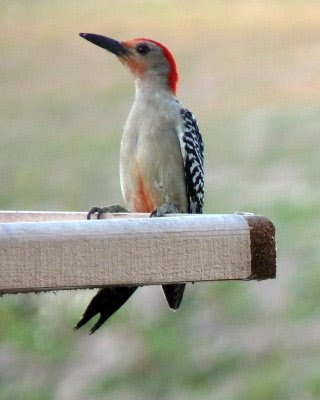 A little over a year ago, when we were doing the initial landscaping in our yard, I decided that I definitely wanted to plant a butterfly garden. I hadn't paid much attention to butterflies in the past, other than to notice a particularly pretty butterfly fluttering by (was there ever such a delightfully perfectly named creature?). But just as I began to notice and love the waterbirds of Florida over time, so it was with butterflies. Once I started looking, they were everywhere, and there were so many kinds with such great names! (The one on the left is a Red Admiral.) I knew I wanted a way to bring them close to me, so I could see them every day.
A little over a year ago, when we were doing the initial landscaping in our yard, I decided that I definitely wanted to plant a butterfly garden. I hadn't paid much attention to butterflies in the past, other than to notice a particularly pretty butterfly fluttering by (was there ever such a delightfully perfectly named creature?). But just as I began to notice and love the waterbirds of Florida over time, so it was with butterflies. Once I started looking, they were everywhere, and there were so many kinds with such great names! (The one on the left is a Red Admiral.) I knew I wanted a way to bring them close to me, so I could see them every day.To get started, I did some research and decided I would use as many native plants as possible. We had gotten our hands on a great little laminated brochure put out by the Florida Museum of Natural History that had native wildflowers on one side and Florida butterflies on the other. It explained that you should plant flowers that would serve not only as food (nectar) for adults, but those that would serve as larval food for caterpillars as well.
As always, finding the native plants was easier said than done, and in the end, I compromised a little with a few species of plants that are not exactly native, but still serve the needs of the butterflies. Here are some my favorites (natives are starred):
- Pineland Lantana* - Great nectar source for all sorts of butterflies. Everyone seems to visit the lantana.
- Lantana Camara - This is a non-native and is considered invasive. But it just attracts so darn many butterflies that I have to have it. The best thing I can do is prune regularly to keep it in check.
- Tropical Milkweed - This is the orange and yellow flowered kind that's easy to find. I really want some white swamp milkweed, which is native, but I haven't been able to find it. You must have milkweed in a butterfly garden - the monarchs and queens adore it and lay their eggs on it.
- Yellow Butterflyweed* - I just got some of this a few days ago, and the monarchs barely waited for me to get it in the ground before attacking it. It seems to be a huge success.
- Passionvine (also called Maypop)* - Another cool plant I just got this year. It has these amazing purple flowers and serves as a larval host for fritillaries and zebra longwings.
Here's a picture of my butterfly garden last fall, just after its summer peak:
 It faces east, and it's really not all that big - about 6 feet by 25 feet. Most of the plants were dormant in the dry winter months (except the blanket flower - that stuff grows like crazy!) and there weren't many butterflies around. This spring, we rejuvenated with some heavy pruning and the addition of fresh milkweed and other plants. I'm always looking for new and interesting butterfly plants to attract new and interesting butterflies, so this garden changes frequently. Here it is more recently:
It faces east, and it's really not all that big - about 6 feet by 25 feet. Most of the plants were dormant in the dry winter months (except the blanket flower - that stuff grows like crazy!) and there weren't many butterflies around. This spring, we rejuvenated with some heavy pruning and the addition of fresh milkweed and other plants. I'm always looking for new and interesting butterfly plants to attract new and interesting butterflies, so this garden changes frequently. Here it is more recently: Of course, the best thing about the butterfly garden is the visitors. They're so darn hard to snap pictures of - they fly away before you can run for the camera. Still, we've gotten some pretty good shots. Check out more at my Flickr Butterfly Gallery.
Of course, the best thing about the butterfly garden is the visitors. They're so darn hard to snap pictures of - they fly away before you can run for the camera. Still, we've gotten some pretty good shots. Check out more at my Flickr Butterfly Gallery.Red Admiral:


Palamedes Swallowtail (L) and Giant Swallowtail (R):


Gulf Fritillary (L) and Monarch (R):


Summer is a great time for butterflies in My Florida Backyard, so look for more posts with pictures of our delicately-winged friends over the next few months!






















